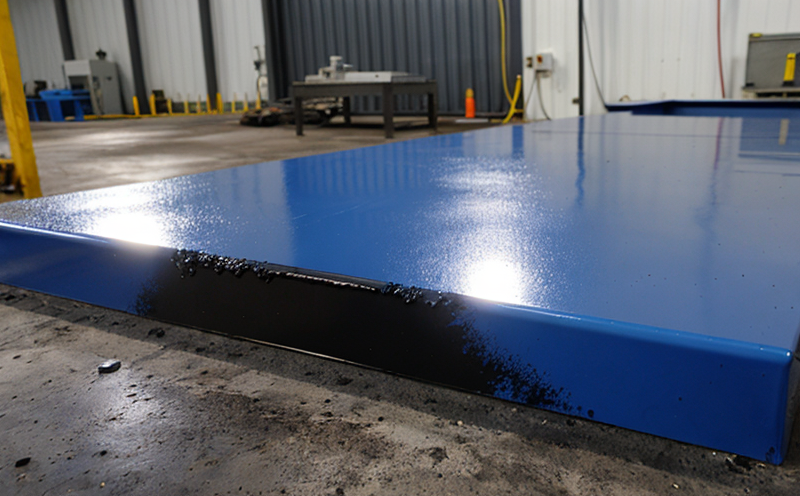ASTM D5894 Cyclic Salt Fog/UV Corrosion Testing of Coatings
The ASTM D5894 cyclic salt fog/UV corrosion test is a standardized method for evaluating the resistance of coatings to environmental exposure conditions that mimic real-world corrosive environments. This test is particularly useful in industries where materials are exposed to aggressive environments, such as marine applications, automotive manufacturing, and infrastructure construction.
The test consists of two main phases: salt fog exposure followed by UV light exposure. The salt fog phase simulates the corrosive effects of marine environments or industrial atmospheres, while the UV phase mimics sunlight damage that accelerates degradation in coatings exposed to direct sunlight. By cycling between these two conditions, ASTM D5894 provides a more comprehensive evaluation of how well a coating will withstand long-term environmental exposure.
The test is designed for various types of coatings including paints, varnishes, and other protective finishes applied to metal substrates. It helps manufacturers and quality assurance teams ensure that their products meet the required durability standards before being deployed in challenging environments.
During testing, specimens are exposed to a controlled environment where salt fog and UV radiation interact. This setup allows for precise control over factors like humidity levels, temperature variations, and light intensity, which can significantly impact coating performance under actual operating conditions.
The cyclic nature of ASTM D5894 ensures that coatings are subjected to realistic aging patterns rather than relying solely on static exposure methods. This approach provides more accurate predictions about the longevity of protective coatings in real-world scenarios.
For instance, in the marine industry, where ships and offshore structures constantly face harsh environmental conditions, this test helps shipbuilders select durable paints that can protect hulls from rusting and corrosion over extended periods without requiring frequent repainting or maintenance. Similarly, automotive manufacturers use ASTM D5894 to assess exterior paint durability on vehicles destined for regions prone to high salt content in the air due to proximity to coastlines.
Understanding these factors is crucial because selecting appropriate coatings early in product development can save costs associated with premature failure and replacement later down the line. Additionally, compliance with industry standards like ASTM D5894 demonstrates commitment to quality control practices that enhance customer satisfaction by delivering reliable products.
Scope and Methodology
| Test Phase | Description | Environmental Parameters |
|---|---|---|
| Salt Fog Exposure | The specimen is exposed to a continuous spray of salt water with a specific pH level and temperature range. | PH: 6.5 ± 0.2, Temperature: 35°C ± 1°C |
| UV Light Exposure | The specimen undergoes exposure to UV light from xenon arc lamps. | Intensity: 75 W/m² ± 10%, Spectrum: 290–400 nm |
The test begins with the application of a protective coating onto a metal substrate. Once dry, samples are prepared according to specified dimensions and thicknesses as outlined in ASTM D5894.
The cyclic exposure process starts by placing the coated specimens into a chamber where they undergo salt fog exposure for a set duration followed immediately by UV light exposure. After each cycle, the samples are inspected visually and with non-destructive testing techniques such as cross-sectioning to assess any changes in appearance or structure.
Acceptance criteria vary based on industry needs but typically involve measuring loss of adhesion between coating layers or substrate surfaces after a specified number of cycles. Compliance ensures that manufacturers meet regulatory requirements while enhancing product reliability and customer trust.
Why Choose This Test
- Comprehensive evaluation of coatings under realistic environmental conditions.
- Precise control over key variables affecting coating performance.
- Accurate prediction of long-term durability in harsh environments.
- Industry standard recognized globally enhancing product credibility.
- Suitable for various types of protective finishes used across multiple sectors.
- Aids in selecting appropriate coatings early in the development process reducing costs associated with premature failures.
The ASTM D5894 cyclic salt fog/UV corrosion test offers a robust framework for assessing coating performance. It provides manufacturers and quality assurance teams with valuable insights into how well their products will withstand harsh environmental conditions, thereby improving overall product reliability and customer satisfaction.
Customer Impact and Satisfaction
- Enhanced durability of coatings leading to extended product lifecycle and reduced maintenance costs.
- Increased trust in the quality of products meeting recognized industry standards like ASTM D5894.
- Improved reputation among clients and stakeholders through consistent delivery of high-quality materials.
- Competitive advantage by demonstrating commitment to rigorous testing protocols that ensure superior performance.
By choosing ASTM D5894 cyclic salt fog/UV corrosion testing, customers gain confidence in the durability and reliability of their products. This not only enhances customer satisfaction but also fosters long-term relationships built on trust and quality assurance.





